26 May: the InkaExpress: Puno to Cusco
We took a taxi to the bus terminal at 7am to catch the
InkaExpress
to Cusco.
The
InkaExpress
is a
tourist
bus that
stops at
a
few
sites
along the
way in
order
to break
up the
6 hour
drive.
Our
first
stop
was
at
Pukara
where we
visited a
museum to
learn
more
about
the
pre-Inca
and Inca
Culture.
There were
lots of
nice
pre-Inca
carved
stones on
display
that had
been found
at an
archeological
site
nearby. Then
a quick
halt at a
pass,
called
La
Raya,
at
the
highest
point of
the
journey
(4335
metres
above sea
level). Lots
of local
handicraft
was for
sale,
including
some
rather
nice
Alpaca
rugs that
caught our
eye, but
unfortunately
we
don't
have
enough room
in our
bags to
buy bulky
souvenirs!
After La Raya the countryside changed drastically; it was much
greener
and there
was more
agriculture
than over
the other
side
of
the
pass.
We
stopped
about half
way for a
buffet
lunch
accompanied
by a
couple of
musicians
in
traditional
dress
playing
Peruvian
music.
Next we
headed
to
the
interesting
Inca ruins
at Raqchi.
Raqchi was
a large
walled
city
in
its hay
day,
but
today
only remnants
of walls
remain.
However
the
temple ruins
are
impressive
as are the
many
circular
buildings
used for
stocking food
supplies.
The last
stop
of
the day
was
at the
beautiful
church in
Andahuaylillas, nicknamed America's
Sixtine
Chapel.
It
was
built
in 1572
and the
interior
is painted
from top
to bottom
and
adorned
with lots
of gold
and
silver. It
was interesting
to
see the
mix of
Catholic
and Inca
cultures
in the
church,
for
example
the
Inca
cross
is
painted
on
Catholic
religious
scenes,
mirrors
adorn
alter
pieces and
native
food and
plants
replaced
European
equivalents
on
paintings.
It has to
be said
that the
Spanish
were
very
heavy
handed
when they
conquered
Peru: they
destroyed
as much
of
the
Inca culture
as
possible
and built
their
churches
over
existing
Inca
temples.
We arrived in our hotel, Las Portales, at about 6pm. We all
agreed
that the
tourist
bus was a
pleasant
way to
travel;
a non-stop
bus
journey
would have
been a
drag.
After
settling
in and
doing the
kids
homework
we went
out into
the
animated
streets
for a bite
to
eat.
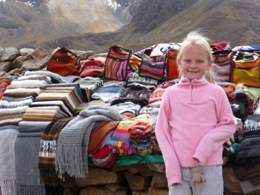 |
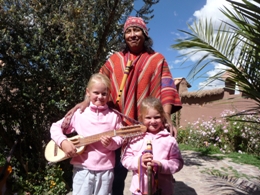 |
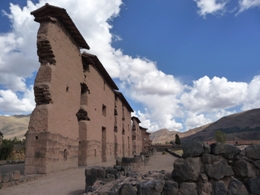 |
| La Raya |
Gaelle and
Sophie
playing
Peruvian
instruments! |
The ruined
temple
at
Raqchi |
27 May: Cusco
We had a bit of a lie in this morning before heading out into the
streets of
Cusco to
explore
the
town. Fortunately
we hadn't
planned
to
go to
Machu
Picchu
today as
there's a
strike in
Cusco
today
and
the
trains
aren't
running... We
bought a
tourist
ticket
to
visit
16
of the
principal
sights in
and around
Cusco and
headed
to
the
Plaza
de
Armas.
The
cathedral
and the
Compania
church
were both
closed
until 10am
so we took
our time
and walked
leisurely
around
the
historic
part of
the city.
The Inca
walls that
survived
the
Spanish
destruction
are
impressive.
They used
huge
stones and
carved
them
impeccably
so that
they
fitted
together
perfectly:
no cement
was
required,
the stones
fit so
well
together
that one
can't even
poke a
needle
between
them!
After we visited the cathedral, but unfortunately the
entrance
ticket
wasn't
included
in our 16
site
ticket...
The
cathedral
is impressive
in its
size and
decoration.
We toured
the
inside
of
the cathedral with
informative
audio
guides. Gaelle was
chuffed to
bits as
she was
given one
despite
the
notice stating
that they
weren't to
be given
to
children
under 13!
The tour
lasted
over an
hour and
the girls
were
crying
famine as
we left.
We ate
lunch in
McDonalds
on the
Plaza
de
Armes,
the
first
one
we'd
seen
in
Peru,
watching
the
strikers
demonstrate
outside
around the
square.
Next we took a taxi to Saqsaywaman, a few kilometres from Cusco,
to visit
the
remains
and
foundations
of a
colossal
Inca
fortress.
The
fortress
has
three-tiered
defence
walls made
of stones
that
fit with
razor
sharp
precision.
The
largest
stone
weighs
about
70
tons!
It's
such
a
pity
that
the
Spaniards
used the
site as a
quarry
for
the
Cusco
cathedral...
Opposite
the
fortress
is a hill
with
remains of
Inca walls
and rocks
that have
been impressively worn by
glaciers.
The rocks
are so
smooth
that you
can slide
down them!
Francois
and the
girls had
great
fun!
There
are
also
tunnels
dug
through
the rocks,
which were
fun
to explore
with our
lamps.
We walked a kilometre or so to the next site, Q'enqo. It's a
sanctuary
with a
monolith,
underground
galleries
and an
underground table used
for
sacrifices. It
was fun to
explore
the site.
Taxis were
hard to
come by,
due to the
strike, so
we walked
the 4
kilometres
back to
the town
centre. We
tried to
visit
the
Qorikancha
museum,
but it was
closed due
to the
strikes...
The
setting
was lovely
however, a
large
grassy
area with,
in the
backdrop,
the Santo
Domingo
church and
convent
built over
the Inca
Qorikancha
temple.
We had planned to go to the Qosqo Centre of Native Art in the
evening to
see a
native
dance
show, but
guess
what, it
was closed
due to the
strikes...
Instead we
went to
see the
Plaza de
Armes by
night
and
ate in
a
nearby
restaurant.
Whilst we
were dining
there
was
a
power
cut so
we
finished
our meal
by
candlelight!
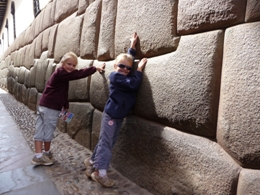 |
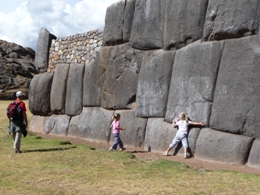 |
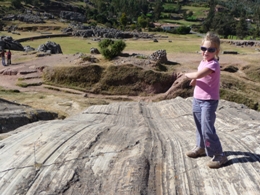 |
| Remains of
Inca
walls
in
the
city |
The Inca
fortress
at
Saqsaywaman |
The glacier
formed
slide! |
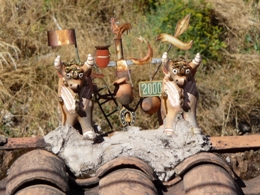 |
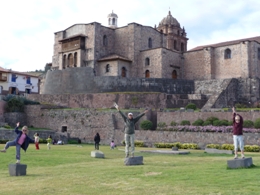 |
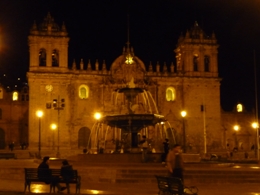 |
| Bulls on
roofs:
A
tradition
in
Cusco! |
Santo
Domingo
church
and
convent
built
over
an
Inca
temple |
The cathedral
by
night |
28 May: The Sacred Valley
We left Cusco by bus for a day's excursion along the Sacred
Valley.
Our first
stop was
at a
lookout
point
where we
had our
first
view
of
the
Sacred
Valley
and
the Urubamba
river.
François
noticed
that the
two front
tyres were
so worn
that one
could see
the
steel
reinforcement.
In
addition
the road
was windy
and there
was
absolutely
no barrier
to prevent
vehicles
from
tumbling
down
hundreds
of metres
into the
valley
below. He
complained
to the
guide
and driver
stating
that if
the tyre
burst, we
could all
die.
Fortunately
they took
him
seriously
and
interchanged
the next
two
stops
in
order
to
change
the
tyres.
Whilst the
tyres were
being
changed
we
walked
around a
colourful
crafts
market at
Pisaq,
selling
silver
jewellery,
knitwear,
fossils
and
crystals.
Then we
drove
further
up
the
valley
to
visit
the
Pisaq archeological
site.
There
are
impressive
stone
terraces
with
surrounding
villages
in
ruins
perched on
the valley
slopes. We
walked
along the
mountain,
through
a
tunnel
carved
through
the
rock, to
a
watchtower.
From
this
vantage
point we
had
a lovely
view of
the valley.
The next stop was for lunch at Urubamba. Our group was
surprisingly
distributed between
three
different
restaurants
depending
upon our
tour
agencies.
We had a
pleasant
surprise
as we
found
ourselves
in a very
nice
restaurant
in an old
convent.
We ate
a
buffet
lunch
on a
sunny
terrace
surrounded
by lovely
gardens
where
there
were musicians
playing
traditional
music.
After lunch we continued our route to the archeological site in
Ollantatambo. It
used to be
a large
city with
impressive
regular
terraces
for
growing
crops and
a temple
to worship
the sun.
The
Inca's
really
knew how
to build
quality
constructions;
the
stonemasonry
is really
impressive!
When asked
whether
sacrifies
were
performed
at the sun
temple the
guide was
defensive
stating
that the
Incas
never
performed
human
sacrificies.
When
challenged
with Juanita,
the ice
maiden, he
said that
she was
actually
placed in
the
ice for
mummification
purposes,
not as
an
offering
to the
mountain
gods, and
subsequently
forgotten
on
the
mountain.
Not a
very
believable
version of
events
considering
the
scientific
evidence
presented
at
Arequipa...
We were dropped off back in Urubamba to catch a taxi to our
hotel: a
very nice
and quite
hotel
called
Aruma
Valle. We
negotiated
the taxi
for the
next day
to take us
to Maras,
Moray and
Las
Salinas. And
after
settling
into our
room we
went for a
walk to
see the
Inca
palace of
Huaynacapac,
finishing
up in a
pizzeria
for
dinner. We
took a
tuk-tuk
back from
town to
the hotel,
which
reminded
us of our
adventures
in
Thailand,
except
that in
Thailand
we weren't
dressed up
in two
fleeces...!
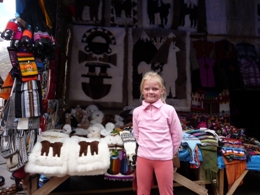 |
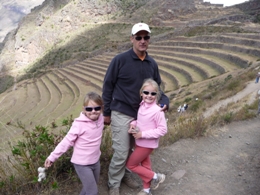 |
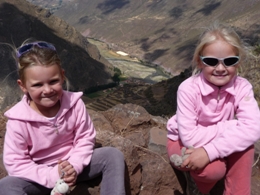 |
| Gaelle at the
market
in
Pisaq |
The terraces
in
Pisaq |
Pisaq and the
Scared
Valley |
29 May: Moray, Las Salinas and Aguas Calientes
Enough of group excursions, this morning we're going to visit two
sites off
the main
tourist
loop with
a taxi
that we'd
reserved
yesterday.
The first
site,
Moray,
above the
remote
village of
Maras
is
exceptional:
there are
3 crater
like
depressions in
the
ground
whose
internal
slopes are
covered
with
concentric Inca
terraces
for
experimental
agriculture.
The site
is really
beautiful
and
as one
descends
the
terraces
to the
bottom of
the
depressions,
the reason
for
building
such
elaborate
terraces
is
evident:
it's at
least
5
degrees
warmer at
the bottom
and one
can't feel
the wind
at
all.
Unfortunately
the origin
of the
depressions
remains a
mystery:
volcanic,
meteorite
or
other???
Our second site is Las Salinas, the salt terraces, after a
short halt
to admire
the
exterior
of the
colonial
church in
Maras. There's
a small
source of
salty
water in
the valley
below
Maras
which has
been
exploited
since the
time
of
the
Inca's
to
produce
salt.
Water is
distributed
into small
shallow
basins
down the
slopes of
the valley
and left
to
evaporate
with
the
help
of
the
suns
rays,
leaving
the
precious
salt ready
for
harvesting
and
transporting
down the
valley by
donkeys.
There are
over
4000
salt
basins
which
continue
to be
exploited
with the
same
techniques
and
gestures
that were
used 600
or 700
years ago!
We
walked along
the narrow
salty
paths
between
salt
basins, alongside
the main
canal of
salt
water. The
landscape
is
unusual
and stunning!
We walked
for about
an hour,
overtaking
donkeys
laden
with bags
of slat
along the
way, to
the
Urubamba
river
where our
taxi
picked us
up.
We ate lunch in a small restaurant in the village, returned to
our hotel
to pick up
our
luggage
and went
to the bus
station to
take
a
bus,
called
a
"collectivo",
to
Ollantaytambo.
It's a
local bus,
packed
with
locals and
school
children
and the
price is
unbeatable:
1,20
Sol,
that's
30
centimes
of an euro
for a
journey of
30 km...!
We passed
from one
extreme to
the other
by next
taking the
train to
Aguas
Calientes.
There's no
road to
Aguas
Calinetes
and Machu
Picchu and
PeruRail
has the
monopoly
of
transporting
tourists
to the
most
visited
monument
in
Latin
America.
They are
the proud
winners of
the award
for most
expensive
train per
kilometre!
The 50
km trip
takes
almost 2
hours:
most of
the time
the train
is at a
stand
still
waiting
for trains
in the
opposite
direction
to pass as
there's
only
one
track...!
It was dark by the time we arrived in Aguas Calinetes. We found
our
hotel situated
between
the river
and the
railway
track and
our
room
with
3
single beds;
the next
two nights
are going
to
be a
bit
of a
squash!
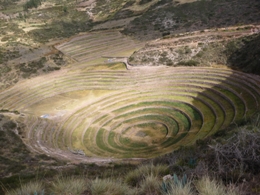 |
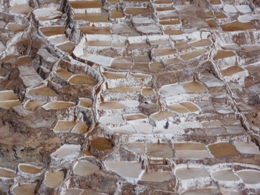 |
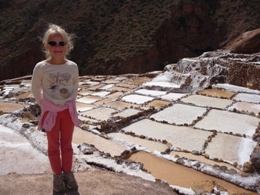 |
| Moray |
Las Salinas -
The
salt basins |
Gaelle and the
valley
of salt basins |
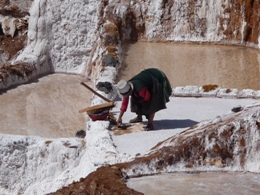 |
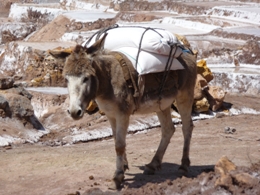 |
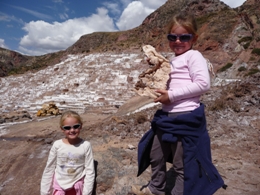 |
| A Peruvian
harvesting
the salt |
Transporting
the
salt to the valley |
Sophie with a
big
clump of salt |
30 May: Machu Picchu
As recommended we got up early to visit the famous site of Machu
Picchu. At
6:30am we
took the
bus up the
400
metres to
the
entrance
of the
site. We
were hit
with a
splendid
view of
the
terraces,
agricultural
buildings
and
surrounding
mountain
peaks as
soon
as we
entered
the site.
We were
thrilled
with the
first
impressions
of the
site and
excited by
the
prospect
of having
all
day to
discover
the lost
Inca city.
We walked
directly
to the far
end of the
site to
climb
WaynaPicchu.
Only 400
people are
allowed to
climb the
mountain
per day so
we wanted
to be sure
that we
could
climb
to
the top
to
be
rewarded
with the
spectacular
view of
the
stone
city
and
surrounding
mountains
and
valleys.
We waited
in-line
for almost
an hour to
have the
"privilege"
to climb.
The 1
hour hike up
the steep
and high
stone
steps
is not
easy, but
the girls
walked
like
champions
and we
overtook a
lot of
people
on
the
way!
The
view
from
the
top
was
spectacular,
but the
ruins
are
a bit
distant to
appreciate
the city
in
detail.
After having descended WaynaPicchu, we started our more detailed
tour of
the site
at the
guardhouse.
We
actually
preferred
the view
from the
guardhouse,
a mere 10
minute
walk above
the
entrance
to
the
site,
compared
to the
view from
WaynaPicchu!
As advised
by fellow
travellers,
we
had
packed
sandwiches
and
water
in
our
rucksack
despite
the rule
that
bottles of
water and
all
food
is
forbidden.
We weren't
the only
rule-breakers
as almost
everybody
had
brought food
and drinks
up because
Orient
Express,
the sole
vendors
at
the
site
entrance,
sell food
and water
at an
extortionate
price; as
an example
a
330ml
bottle of
water was
being sold
for 8
Sol, whereas
normally a
2.5 litre
bottle
costs only
4 Sol!
That's 15
times more expensive! We sat down for a
picnic
lunch
on a
quiet
terrace
with a
superb
view over
the Inca city.
After lunch, we negotiated with a guide to
join an
English
guided
group for
12 US$, in
order
to obtain
explanations about
the city.
It was
interesting,
but
much still
known
about the
Inca way
of life.
Then we
took some
time to
explore
the ruins
independently,
crawling
into the
Condor
Temple
underground
cave
complete
with
sacrificed lamas and
walking
into
houses and
temples.
The whole
site is really
beautiful
and we had
fulfilled
yet
another
dream by
visiting the
wonderful
Inca city
of Machu
Picchu.
We revived our tired limbs in the outdoor thermal baths in
Aguas
Calientes,
where the
temperature
was a
comfortable
38 degrees.
Then
dinner at
a
restaurant
under the
entrance
to the baths called
In Ti
Raymi:
avoid
it!!! They
enticed us
into the
restaurant by
stating
that the
children
would eat
for free
and then
charged us 4
full price
menus...
It was the
most
expensive
restaurant
we'd paid by far in
Peru to
date,
despite
the fact
that we
compromised by paying 3 menus
in the
end! Machu
Picchu and
Aguas
Calientes
are renouned
for being
a
expensive,
with
minimal
service but we didn't think we'd
meet such
blatant
swindles...
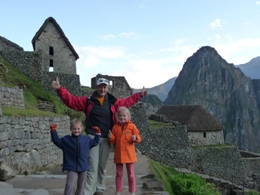 |
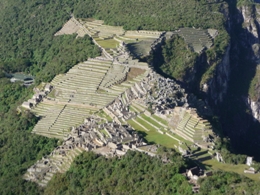 |
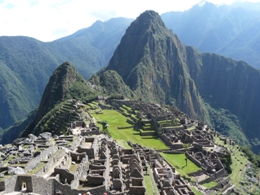 |
| Yes, we made
it
to Machu Picchu! |
The view from
WaynaPicchu |
The view from
the
guardhouse |
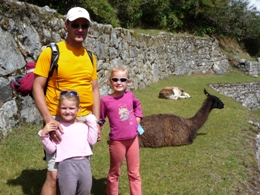 |
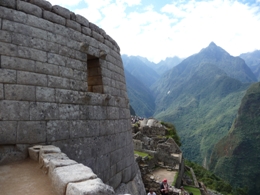 |
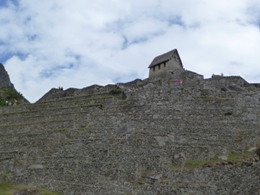 |
| Picnicing on
the
terraces with the lamas! |
The sun
temple |
The guardhouse
and
agricultural
terraces |

BACK
| 
